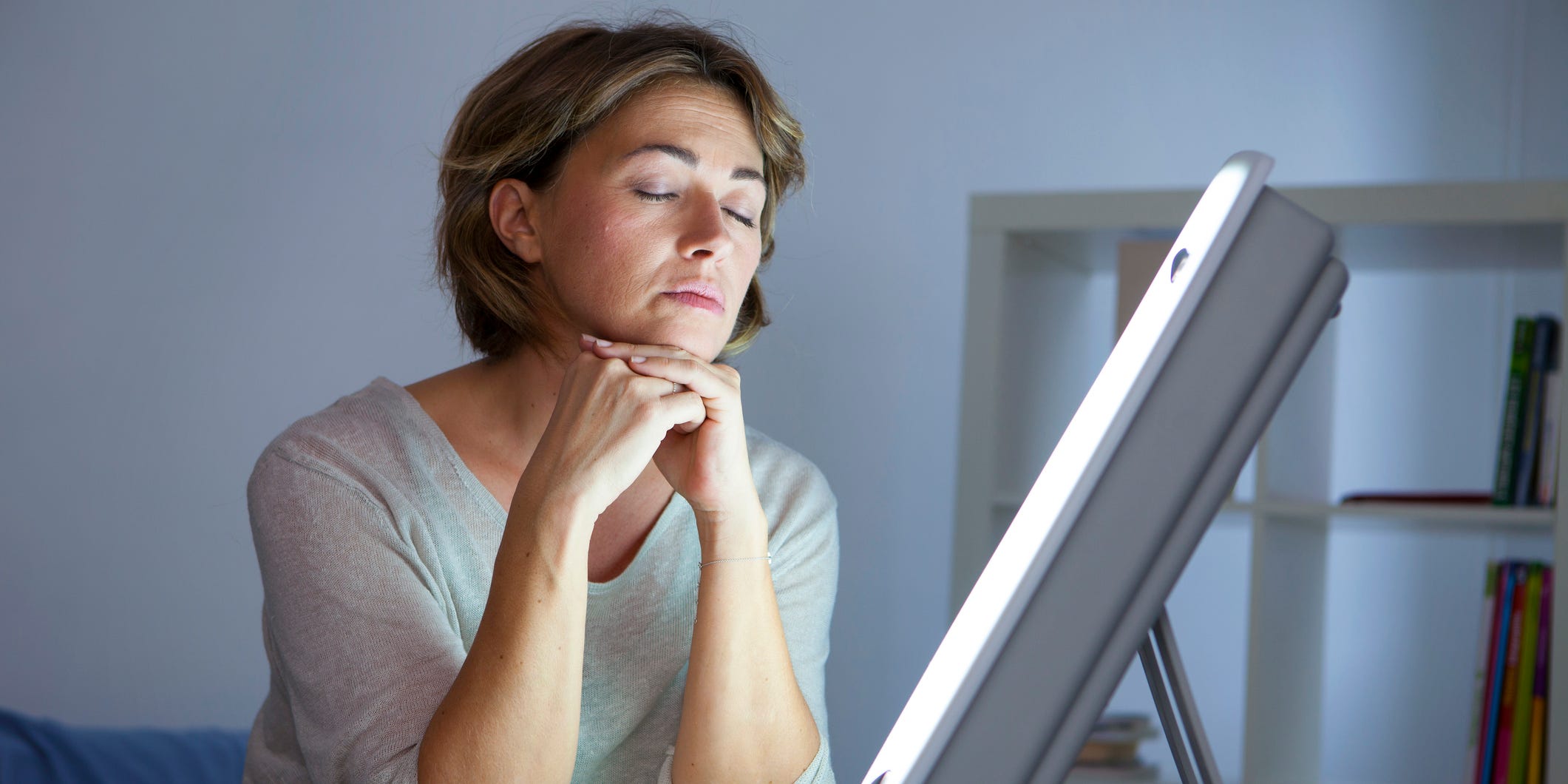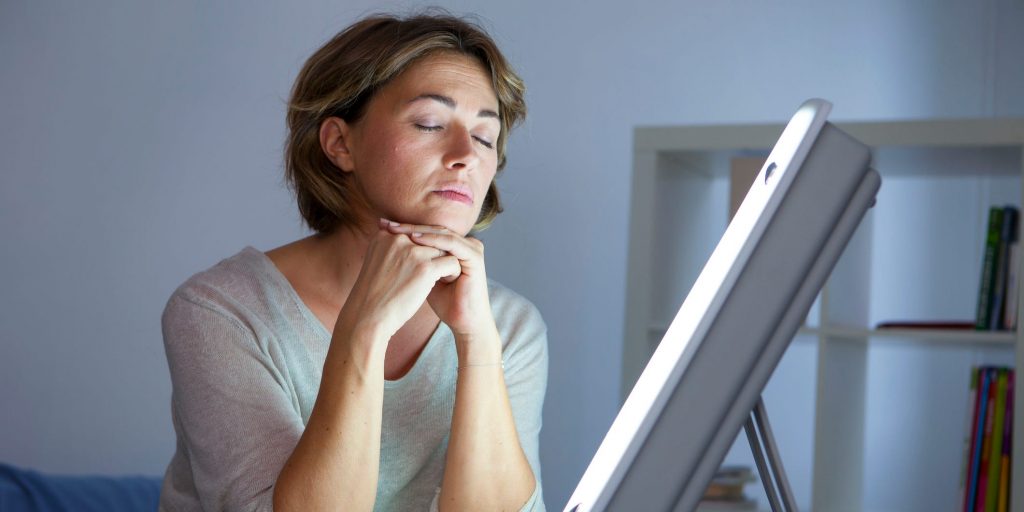
- Light therapy can help treat seasonal affective disorder (SAD), which affects 4% to 6% of Americans.
- A light box works by helping regulate dopamine and serotonin levels to relieve depressive symptoms.
- For it to work, spend 20-30 minutes in front of a 10,000-lux light box each day during winter months.
- Visit Insider's Health Reference library for more advice.
Light therapy is considered a first-line treatment for seasonal affective disorder (SAD), a type of depression that occurs during the fall and winter. Here's more about this treatment and how to use it effectively.
What is seasonal affective disorder (SAD)?
About 4% to 6% of American adults have SAD, which comes on in the fall and winter, and usually abates in the spring and summer. Research has linked SAD to changes in the amount of daylight and found that it's more common in areas that are far from the equator and thus have shorter, darker days in the winter.
"SAD is generally a dip in mood into a depressive state," says Gonzalo Laje, MD, director of Washington Behavioral Medicine Associates, LLC, and clinical associate professor of psychiatry and behavioral sciences at The George Washington University in Washington D.C.
"It is a real thing, and we have a very interesting approach to treatment, not just traditional antidepressants, but also with light therapy," he says.
To understand how light therapy works, it's important to understand the biological causes of SAD. Research shows that people with SAD have three potential biological causes that contribute to their depression during the darker months:
- They have trouble regulating serotonin transporter protein. These proteins bind to the neurotransmitter serotonin and make it inactive. One study found that people with SAD have more serotonin transporter during the winter months. This leaves less serotonin available, and low levels of serotonin have been linked to depression.
- They overproduce melatonin. Melatonin is a hormone that encourages sleep. The body produces it when it's dark, but people with SAD over-produce melatonin, leaving them feeling sleepy, lethargic and interrupting their circadian rhythms, or internal body clocks.
- They underproduce vitamin D. Vitamin D, which is activated by exposure to the sun, can help regulate mood. Low vitamin D levels are associated with depression.
How light therapy works
Light therapy can help regulate melatonin and serotonin levels thereby offsetting some of the depressive symptoms associated with SAD.
How light therapy works is that it aims to make up for the bright light that people aren't getting during the winter months, especially in colder, darker climates.
"There's a clear relationship between environmental light — sunlight — and mood," Laje says. "What light therapy attempts to do is to overcome a little bit of that lack of light with artificial light."
A 2006 double-blind randomized controlled clinical study found that light therapy improved symptoms in 67% of patients, the same amount who saw improvement on the antidepressant fluoxetine, part of the SSRI class of drugs. Selective serotonin reuptake inhibitors (SSRIs) are the most commonly prescribed antidepressants.
The reason experts think light therapy is so successful is how it regulates serotonin and melatonin production. For example, researchers have found that light therapy can reduce serotonin transporter binding, leaving more of the feel-good serotonin hormone available in the brain.
Scientists have also found that increasing daytime light exposure with artificial lights could reduce daytime melatonin levels in people experiencing SAD.
How to effectively practice light therapy
Simply having a brightly-lit room is not effective light therapy, Laje says. To get the benefits of light therapy, you need to be exposed to a 10,000-lux light box for 20-30 straight minutes each day.
For the light therapy to work, Laje says that you need to sit 1.5 to 2 feet from the light box. It will feel slightly uncomfortable because it's so bright.
"It has to be slightly uncomfortable to be effective," he says. "It's very, very bright. You lose efficacy very quickly if you're far away."
The brightness could harm your eyes, however, so you should never look directly at the lamp. He recommends staying engaged while you're sitting near the light box by reading a book or a newspaper.
Since light therapy affects your biological clock, Laje recommends doing it in the morning, and never in the afternoon, since that could disrupt your normal sleep-wake pattern and could make it harder for you to fall asleep that night.
He recommends that patients do 20-30 minutes of light therapy daily, starting in late September or early October and continuing through the winter months.
Health considerations for light therapy
"While light therapy seems almost trivial, it can cause problems," Laje says.
For example, people with bipolar disorder could become manic and should only use light therapy under the direction of their doctor, he says. That's why it's always important to talk to your doctor and seek their guidance before starting a light therapy regimen.
Light therapy, alone, may work for some people, but sometimes others may also need anti-depressants or counseling, Laje says. If your depression symptoms are not improving or are worsening under your treatment plan, immediately reach out to your doctor.
Because the lamps used in light therapy do not put out UV rays, there is no cancer risk, Laje says.
Insider's takeaway
Light therapy is an effective way of helping to control the symptoms of seasonal affective disorder. The low light of winter can impact serotonin and melatonin levels, leaving you feeling sluggish, tired, or depressed.
Spending 20-30 minutes in front of a very bright lamp of around 10,000 lux units can help overcome SAD symptoms, regulate your circadian clock, and help you feel better during the winter months, Laje says.
"I'm always fascinated by these approaches, that are simple, effective and generally safe," he says. "With light, we can help our mood."
